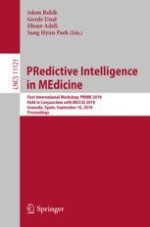2018 | OriginalPaper | Buchkapitel
Multi-modal Neuroimaging Data Fusion via Latent Space Learning for Alzheimer’s Disease Diagnosis
verfasst von : Tao Zhou, Kim-Han Thung, Mingxia Liu, Feng Shi, Changqing Zhang, Dinggang Shen
Erschienen in: PRedictive Intelligence in MEdicine
Aktivieren Sie unsere intelligente Suche, um passende Fachinhalte oder Patente zu finden.
Wählen Sie Textabschnitte aus um mit Künstlicher Intelligenz passenden Patente zu finden. powered by
Markieren Sie Textabschnitte, um KI-gestützt weitere passende Inhalte zu finden. powered by
